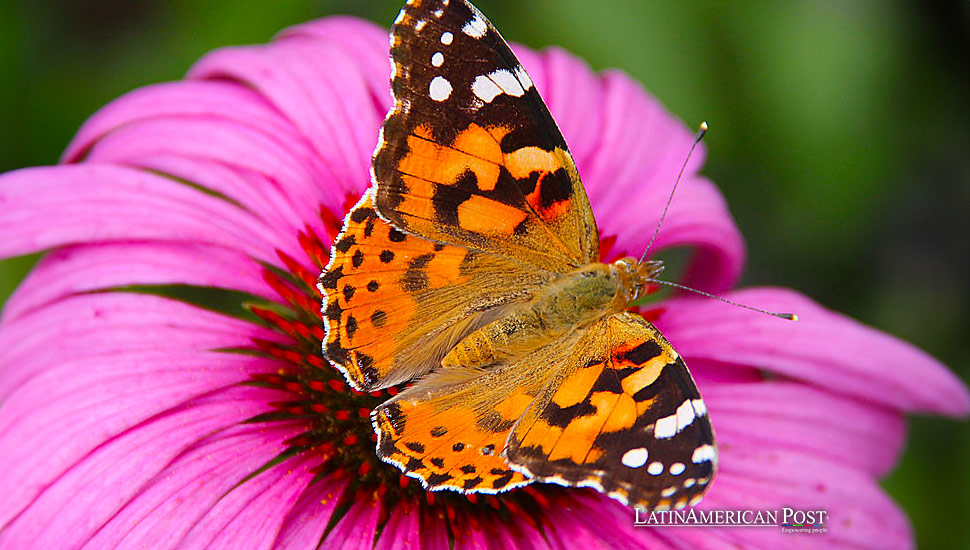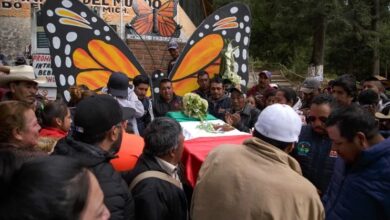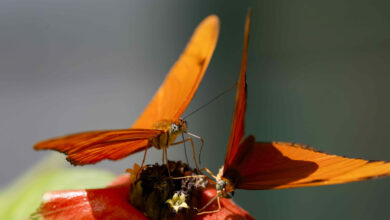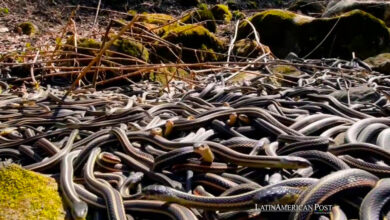French Guiana Discovery Reveals Butterflies’ Epic Transatlantic Journey

An international team of scientists has documented an extraordinary transatlantic flight by “painted lady” butterflies, Vanessa cardui, from Africa to French Guiana, revealing an incredible 4,200-kilometer journey. This groundbreaking research opens new perspectives on insect migration and its ecological impact.
In a discovery that reshapes our understanding of insect migration, an international team of scientists has documented for the first time the awe-inspiring journey of a group of “painted lady” butterflies, known scientifically as Vanessa cardui, as they flew across the vast Atlantic Ocean. This astonishing journey spans over 4,200 kilometers from Africa to French Guiana in South America, marking a record for insect migration.
The study, led by the Spanish National Research Council (CSIC) and published in Nature Communications, details how these butterflies accomplished their five- to eight-day transoceanic flight. The feat was made possible by the trade winds, a consistent pattern of winds that blow from east to west in the tropics, which helped the butterflies conserve energy throughout their journey by providing a steady tailwind.
The study, a testament to the power of international collaboration, involved researchers from several institutions, including the Botanical Institute of Barcelona (CSIC-Barcelona Natural Science Museum), the Władysław Szafer Botanical Institute (Poland), the University of Ottawa (Canada), the Institute of Evolutionary Biology (IBE, CSIC-Universitat Pompeu Fabra), and Harvard University (USA). The breakthrough began in October 2013 when Gerard Talavera, a researcher at the Botanical Institute of Barcelona, identified several painted lady butterflies on the beaches of French Guiana. This observation was unusual because this species is not native to South America.
The researchers employed a multidisciplinary approach to solve the mystery of the butterflies’ origin and migration route. They initially considered two main hypotheses: the butterflies could have originated in North America or Africa/Europe. To test these hypotheses, the team analyzed wind trajectories using data from weather stations and satellite imagery, and observed a consistent directional pattern from West Africa, suggesting the butterflies had crossed the Atlantic. They also conducted genetic analysis, examining the butterflies’ DNA to determine their relationship to other populations, and examined the butterflies’ pollen, identifying two plant species found only in tropical Africa, confirming their visit to African flowers before their transatlantic flight.
Further genetic analysis showed that the butterflies found in South America were related to populations in Europe and Africa, effectively ruling out North America as their origin. The researchers also examined the butterflies’ pollen, identifying two plant species found only in tropical Africa, confirming their visit to African flowers before their transatlantic flight. This finding underscores the importance of international collaboration in biodiversity research, as it demonstrates how the study of one species can provide insights into the ecosystems of multiple continents.
The Journey of a Lifetime
The team also analyzed stable isotopes of hydrogen and strontium in the butterflies’ wings, which retain isotopic signatures from their larval habitats. Stable isotopes are variants of chemical elements that do not decay over time, and their ratios can provide information about an organism’s diet, habitat, and migration patterns. This analysis suggested that the butterflies originated from Western European countries such as France, Ireland, the United Kingdom, and Portugal.
“The painted lady butterflies reached South America from West Africa, flying at least 4,200 kilometers across the Atlantic. But their journey could have been even longer, possibly starting in Europe and crossing three continents, amounting to a migration of 7,000 kilometers or more—an extraordinary feat for such a small insect,” explained Clément Bataille, a professor at the University of Ottawa and co-author of the study.
“Butterflies are often seen as symbols of fragile beauty, but science shows us they can achieve incredible feats. There is still much to discover about their capabilities,” highlighted Roger Vila, a researcher at the Institute of Evolutionary Biology (CSIC-Universitat Pompeu Fabra) and co-author of the study.
Harnessing the Winds
The researchers modeled the energy cost of the butterflies’ journey and calculated that the transatlantic flight, without any stops, lasted between five and eight days. Favorable wind currents aided their flight.
“The butterflies could only have completed this flight by using a strategy that alternated between minimal effort to avoid falling into the sea and active flight, which requires higher energy consumption. We estimated that without wind, the butterflies could have flown a maximum of 780 kilometers before exhausting their fat reserves and, therefore, their energy,” clarified Eric Toro-Delgado, one of the study’s authors.
The findings suggest natural aerial corridors connecting continents and facilitating species’ dispersion on a much larger scale than previously imagined. “This discovery opens new perspectives on the capabilities of insects to disperse over long distances, even across seas and oceans. We may be underestimating the frequency and impact of these movements on our ecosystems,” observed Gerard Talavera, the study’s lead researcher.
Implications for South America and Beyond
The discovery of the painted lady butterflies’ migration to South America has significant implications for understanding the dynamics of insect migration and its potential impact on ecosystems. Insects, as crucial players in pollination, food webs, and as indicators of environmental change, can significantly influence local biodiversity and ecological interactions. The ability of butterflies to travel such vast distances underscores the urgency of studying and protecting ecosystems.
This research also highlights the importance of international collaboration in studying and preserving biodiversity. The multidisciplinary approach used in this study—combining genetic analysis, wind pattern studies, pollen examination, and isotope analysis—demonstrates the power of integrating different scientific methods to uncover complex ecological phenomena.
The findings underscore the need for South American countries to monitor and understand the movement of species across regions. As climate change continues to alter habitats and migration patterns, it becomes increasingly vital to study how these changes affect local ecosystems and develop strategies to protect biodiversity. This research also highlights the importance of international collaboration in studying and preserving biodiversity, as it demonstrates how the movement of a single species can have implications for ecosystems on multiple continents.
Such research is crucial in Latin America, where biodiversity is among the highest in the world. The continent’s varied climates and habitats make it a unique laboratory for studying ecological interactions and the impacts of global environmental changes. Understanding the migration patterns of insects like the painted lady butterfly can provide insights into broader ecological processes and help inform conservation efforts. This study serves as a reminder of the unique opportunities for biodiversity research in Latin America and the importance of international collaboration in studying and preserving the region’s rich natural heritage.
Looking Forward
The epic journey of the painted lady butterflies from Africa to South America is a testament to nature’s resilience and adaptability. It challenges our perceptions of small creatures’ limitations and opens new avenues for research into insect migration and its ecological implications.
As researchers continue to unravel the mysteries of insect migration, there is potential to discover even more remarkable behaviors and strategies employed by these resilient creatures. For instance, future studies could focus on the role of genetic factors in determining migratory behavior, or on the potential impacts of climate change on insect migration patterns. The knowledge gained from such studies can inform conservation strategies, helping to protect and preserve biodiversity in a rapidly changing world.
This study serves as a reminder to scientists and conservationists in South America and beyond of the interconnectedness of global ecosystems. It emphasizes the importance of protecting natural habitats and understanding the complex movements of species that contribute to the health and stability of our environment.
Also read: Geopolitical Chess Unravels as U.S. Boosts Guyana’s Military Amid Venezuela Territorial Dispute
The discovery of the painted lady butterflies’ transatlantic journey is a remarkable achievement that highlights insects’ incredible capabilities and the importance of multidisciplinary research. It calls for continued efforts to study and protect our planet’s diverse and dynamic ecosystems, ensuring that nature’s wonders continue to inspire and thrive for generations to come.





